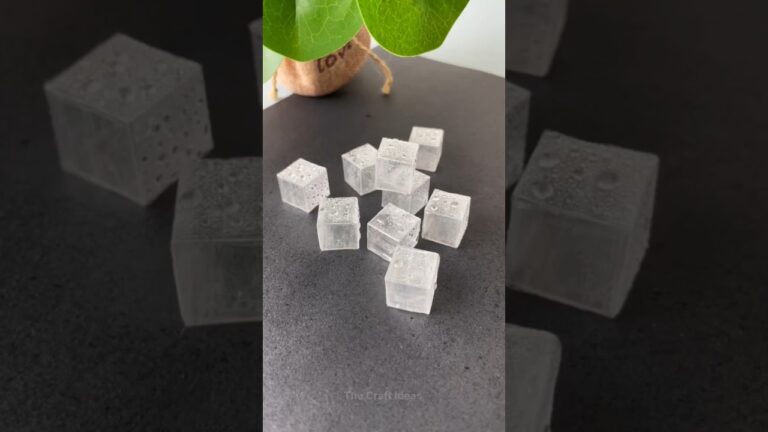[ad_1]
Creating fake ice cubes with cellophane tape is a straightforward and inexpensive craft project. Here’s a detailed guide on how to make them, focusing on achieving a realistic look:
Materials You’ll Need:
- Cellophane Tape: Choose a clear, glossy cellophane tape. Avoid matte or frosted tapes as they won’t have the desired transparency. Wider tape can be useful for larger cubes.
- Scissors or Craft Knife: For precise cutting. A craft knife is recommended for clean edges, but use caution.
- Ruler or Straight Edge: To ensure uniform cube sizes.
- Cutting Mat (Optional): To protect your work surface if using a craft knife.
- Sandpaper (Fine Grit – Optional): For slightly dulling the edges to mimic real ice.
- Gloves (Optional): To keep fingerprints off the tape.
Step-by-Step Instructions:
-
Prepare Your Workspace: Clear a flat, clean surface. If you’re using a craft knife, place a cutting mat underneath.
-
Determine Cube Size: Decide on the dimensions of your desired ice cubes. A common size is around 1 inch (2.5 cm) per side. Use a ruler to mark this measurement.
-
Create the Tape Layers:
- Layer 1: Pull out a strip of cellophane tape that’s slightly longer than the desired cube size. Place it sticky-side up on your work surface or cutting mat, securing the ends to prevent curling. If you want the cube to have a hollowed look, use thinner tape.
- Layer 2: Place a second strip of cellophane tape directly on top of the first, sticky-side down. Align the edges as precisely as possible. Smooth out any air bubbles by pressing firmly from the center outwards. If you use a thicker tape, this layer is important.
- Continue Adding Layers: Repeat this process, adding more layers of tape. The more layers you add, the thicker and more substantial your fake ice cubes will be. Aim for at least 6-8 layers for a convincing appearance. Experiment with the number of layers to achieve your desired effect. To improve clarity of the cubes, adding additional layers can help.
- Even Layer Distribution: Ensure that each layer of tape is aligned as closely as possible to the previous one. Overlapping or uneven layers can create visible ridges or distortions.
-
Cut Out the Cube Shape:
- Mark the Dimensions: Use a ruler and marker (or craft knife) to draw (or score) a square or cube shape on the layered tape sheet according to your chosen dimensions.
- Cut Carefully: Using scissors or a craft knife, carefully cut along the marked lines. Aim for clean, straight cuts. A craft knife and a metal ruler offer the most precise results.
-
Optional: Edge Refinement:
- Sanding (For a More Realistic Look): Lightly sand the edges of the tape cubes with fine-grit sandpaper. This will slightly dull the sharp edges, making them look more like real ice that has started to melt slightly. Be very gentle to avoid tearing the tape.
- Rounded Edges: You can also use scissors to carefully round the corners and edges of the cubes for a more natural appearance.
-
Finishing Touches:
- Inspection: Examine the fake ice cubes for any imperfections, such as air bubbles or uneven edges. Try to remove or minimize these as much as possible.
Tips for Realism:
- Air Bubbles: Trapped air bubbles can add to the realistic look, mimicking imperfections in real ice. However, too many large bubbles can detract from the overall appearance.
- Vary the Size and Shape: Create a variety of cube sizes and slightly irregular shapes for a more natural look. Real ice cubes are rarely perfectly uniform.
- Lighting: The appearance of the fake ice cubes will change depending on the lighting. Experiment with different lighting conditions to see how they look.
- Storage: Store your fake ice cubes in a cool, dry place away from direct sunlight or heat, which could cause the tape to warp or discolor.
Variations:
- Colored Ice Cubes: Use colored cellophane tape (if available) or add a thin layer of colored acetate between the tape layers to create colored ice cubes.
- Embedded Objects: Before sealing the final layers of tape, you could embed small objects like glitter, beads, or tiny plastic fruit pieces within the cube for a decorative effect.
- Larger Ice Blocks: For larger blocks, consider using a thicker, more durable tape and reinforcing the edges with additional tape layers.
- Textured Ice: Use a textured roller or press the tape layers onto a textured surface before cutting to create a frosted or uneven surface on the fake ice cubes.
These detailed instructions should help you create realistic fake ice cubes using cellophane tape. Remember that experimentation is key to achieving the desired look and feel.
[ad_2]

